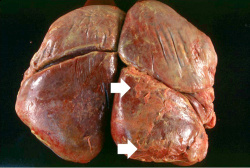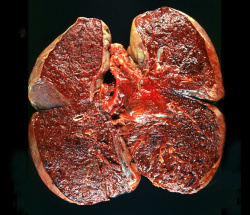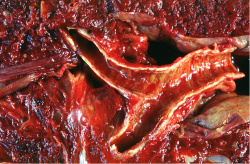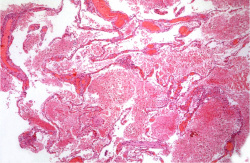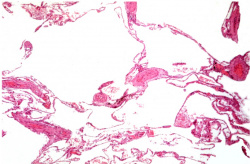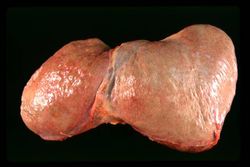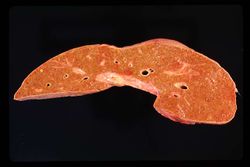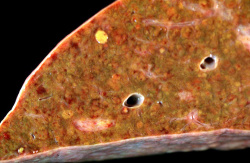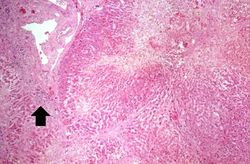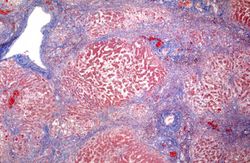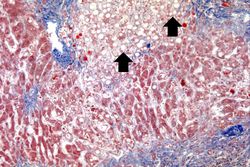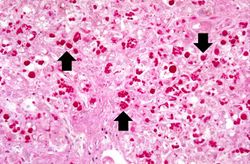Difference between revisions of "IPLab:Lab 5:α1 Antitrypsin Deficiency"
Seung Park (talk | contribs) |
(→Images) |
||
| (7 intermediate revisions by 2 users not shown) | |||
| Line 1: | Line 1: | ||
== Clinical Summary == | == Clinical Summary == | ||
| − | This 68-year-old white female was afflicted with severe emphysema due to | + | This 68-year-old white female was afflicted with severe emphysema due to alpha 1-antitrypsin deficiency. She had a 10 pack-year history of cigarette smoking but she had quit smoking 30 years ago. She elected to undergo lung volume reduction surgery to reduce complications of her emphysema. Post-operatively, she was ventilator dependent and her liver function declined. Further studies revealed hepatic cirrhosis. Her pulmonary function continued to decline and she died 26 days after her surgery. |
| − | + | At autopsy there were severe emphysematous changes in all lung lobes and there was massive hemorrhage throughout the lungs. The liver weighed 860 grams and there was micronodular cirrhosis. | |
| − | |||
== Images == | == Images == | ||
<gallery heights="250px" widths="250px"> | <gallery heights="250px" widths="250px"> | ||
| − | File: | + | File:IPLab5Antitrypsin1b.jpg|This is a gross photograph of the lungs from this case. The rough friable material on the surface of the lung (arrows) is fibrinous exudate and fibrous tissue. This reaction on the surface of the lung is due to the recent surgery. The emphysematous changes are not easily appreciated in this photograph. |
| − | File: | + | File:IPLab5Antitrypsin2b.jpg|This is a gross photograph of the cut sections of lung from this case. The lung parenchyma is markedly hemorrhagic and consolidated. Again the hemorrhage makes it difficult to appreciate the emphysematous changes. |
| − | File: | + | File:IPLab5Antitrypsin3b.jpg|This is a gross photograph of the bronchi and lungs. Note the hemorrhage in the bronchi and in the lung parenchyma. |
| − | File: | + | File:IPLab5Antitrypsin4b.jpg|This low-power photomicrograph demonstrates the hemorrhage present throughout the lung. Note also the large air spaces; even though they are filled with blood, the emphysematous enlargement of the spaces is appreciable. |
| − | File: | + | File:IPLab5Antitrypsin5b.jpg|This is a low-power photomicrograph from an area of the lung without significant hemorrhage. The enlarged, emphysematous air spaces are easily appreciated. |
File:IPLab5Antitrypsin6.jpg|This is a gross photograph of the liver from this case. The capsule is somewhat thickened and the surface is slightly roughened, though it is difficult to appreciate the nodularity of the liver. | File:IPLab5Antitrypsin6.jpg|This is a gross photograph of the liver from this case. The capsule is somewhat thickened and the surface is slightly roughened, though it is difficult to appreciate the nodularity of the liver. | ||
File:IPLab5Antitrypsin7.jpg|This is a gross photograph of the cut section of liver from this case. In this view the liver looks smaller than normal and there is a definite micronodular appearance. | File:IPLab5Antitrypsin7.jpg|This is a gross photograph of the cut section of liver from this case. In this view the liver looks smaller than normal and there is a definite micronodular appearance. | ||
| − | File: | + | File:IPLab5Antitrypsin8b.jpg|This is a closer view of the cut section of liver from this case. There is a definite micronodular pattern to the liver parenchyma. |
File:IPLab5Antitrypsin9.jpg|This is a low-power photomicrograph of an H&E-stained section of liver. There are increased numbers of inflammatory cells in the periportal region (arrow) and the central vein areas are pale. | File:IPLab5Antitrypsin9.jpg|This is a low-power photomicrograph of an H&E-stained section of liver. There are increased numbers of inflammatory cells in the periportal region (arrow) and the central vein areas are pale. | ||
File:IPLab5Antitrypsin10.jpg|This is a low-power photomicrograph of a trichrome-stained section of liver. There is bridging fibrosis (blue material) between portal regions. | File:IPLab5Antitrypsin10.jpg|This is a low-power photomicrograph of a trichrome-stained section of liver. There is bridging fibrosis (blue material) between portal regions. | ||
| Line 26: | Line 25: | ||
* <spoiler text="What role does smoking play in the development of emphysema in patients with α1-antitrypsin deficiency?">Smoking increases the numbers of neutrophils in the lung and accentuates the release of elastase from these neutrophils. With a deficiency of α1-antitrypsin there is marked tissue damage.</spoiler> | * <spoiler text="What role does smoking play in the development of emphysema in patients with α1-antitrypsin deficiency?">Smoking increases the numbers of neutrophils in the lung and accentuates the release of elastase from these neutrophils. With a deficiency of α1-antitrypsin there is marked tissue damage.</spoiler> | ||
* <spoiler text="Is hepatic cirrhosis common in patients with α1-antitrypsin deficiency and what is the pathogenesis of the cirrhosis?">The abnormal α1-antitrypsin protein accumulates in hepatocytes of all patients with this abnormality but only 8 to 20% develop cirrhosis. The exact mechanism for hepatic cirrhosis in patients with α1-antitrypsin deficiency is not well understood.</spoiler> | * <spoiler text="Is hepatic cirrhosis common in patients with α1-antitrypsin deficiency and what is the pathogenesis of the cirrhosis?">The abnormal α1-antitrypsin protein accumulates in hepatocytes of all patients with this abnormality but only 8 to 20% develop cirrhosis. The exact mechanism for hepatic cirrhosis in patients with α1-antitrypsin deficiency is not well understood.</spoiler> | ||
| + | |||
| + | == Additional Resources == | ||
| + | === Reference === | ||
| + | * [http://emedicine.medscape.com/article/295686-overview eMedicine Medical Library: α1-Antitrypsin Deficiency] | ||
| + | * [http://emedicine.medscape.com/article/298283-overview eMedicine Medical Library: Emphysema] | ||
| + | * [http://emedicine.medscape.com/article/807143-overview eMedicine Medical Library: COPD and Emphysema] | ||
| + | * [http://www.merckmanuals.com/professional/pulmonary_disorders/chronic_obstructive_pulmonary_disease_and_related_disorders/alpha-1_antitrypsin_deficiency.html Merck Manual: α1-Antitrypsin Deficiency] | ||
| + | |||
| + | === Journal Articles === | ||
| + | * Perlmutter DH. [http://www.ncbi.nlm.nih.gov/pubmed/11232197 Liver injury in α1-antitrypsin deficiency]. ''Clin Liver Dis'' 2000 May;4(2):387-408, vi. | ||
| + | |||
| + | === Images === | ||
| + | * [{{SERVER}}/library/index.php?/tags/222-emphysema PEIR Digital Library: Emphysema Images] | ||
| + | * [{{SERVER}}/library/index.php?/tags/1854-alpha_1_antitrypsin_deficiency PEIR Digital Library: α1-Antitrypsin Deficiency Images] | ||
| + | * [http://library.med.utah.edu/WebPath/LUNGHTML/LUNGIDX.html#6 WebPath: Emphysema] | ||
| + | |||
| + | == Related IPLab Cases == | ||
| + | * [[IPLab:Lab 2:Fatty Change and Cirrhosis|Lab 2: Liver: Fatty Change and Cirrhosis]] | ||
| + | * [[IPLab:Lab 10:Cryptococcosis|Lab 10: Lung: Cryptococcosis]] | ||
| + | * [[IPLab:Lab 12:COPD|Lab 12: Lung: Chronic Obstructive Pulmonary Disease]] | ||
{{IPLab 5}} | {{IPLab 5}} | ||
[[Category: IPLab:Lab 5]] | [[Category: IPLab:Lab 5]] | ||
Latest revision as of 19:45, 8 July 2020
Contents
[hide]Clinical Summary[edit]
This 68-year-old white female was afflicted with severe emphysema due to alpha 1-antitrypsin deficiency. She had a 10 pack-year history of cigarette smoking but she had quit smoking 30 years ago. She elected to undergo lung volume reduction surgery to reduce complications of her emphysema. Post-operatively, she was ventilator dependent and her liver function declined. Further studies revealed hepatic cirrhosis. Her pulmonary function continued to decline and she died 26 days after her surgery.
At autopsy there were severe emphysematous changes in all lung lobes and there was massive hemorrhage throughout the lungs. The liver weighed 860 grams and there was micronodular cirrhosis.
Images[edit]
This is a gross photograph of the lungs from this case. The rough friable material on the surface of the lung (arrows) is fibrinous exudate and fibrous tissue. This reaction on the surface of the lung is due to the recent surgery. The emphysematous changes are not easily appreciated in this photograph.
Study Questions[edit]
Additional Resources[edit]
Reference[edit]
- eMedicine Medical Library: α1-Antitrypsin Deficiency
- eMedicine Medical Library: Emphysema
- eMedicine Medical Library: COPD and Emphysema
- Merck Manual: α1-Antitrypsin Deficiency
Journal Articles[edit]
- Perlmutter DH. Liver injury in α1-antitrypsin deficiency. Clin Liver Dis 2000 May;4(2):387-408, vi.
Images[edit]
- PEIR Digital Library: Emphysema Images
- PEIR Digital Library: α1-Antitrypsin Deficiency Images
- WebPath: Emphysema
Related IPLab Cases[edit]
- Lab 2: Liver: Fatty Change and Cirrhosis
- Lab 10: Lung: Cryptococcosis
- Lab 12: Lung: Chronic Obstructive Pulmonary Disease
| |||||
Pulmonary emphysema is a condition in which the air spaces distal to the terminal bronchioles are permanently increased in size due to either destruction of the wall or alveolar dilatation.
A pack-year denotes smoking one pack of cigarettes per day for one year.
Cirrhosis is a liver disease characterized by necrosis, fibrosis, loss of normal liver architecture, and hyperplastic nodules.
A normal partial thromboplastin time is 28 to 37 seconds.
Friable material is easily crumbled.
Consolidation is the filling of lung air spaces with exudate--this is a sign of pneumonia.
